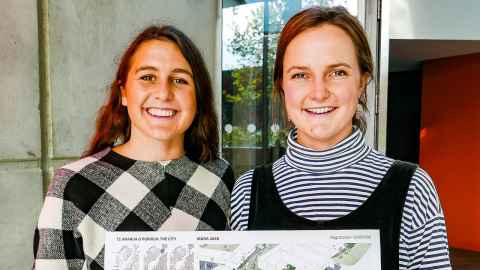‘Utopian’ urban vision wins national prize
1 June 2017
A ‘utopian’ vision for the future of New Zealand cities has seen an Engineering student team up with likeminded people from diverse disciplines to take out a national competition.

Caroline Hope, a Chemical and Material Engineering Honours student, joined forces with family and friends to produce the winning entry in the Imagining Decolonised Cities (IDC) urban design challenge.
Entrants were invited to share their “utopian vision for a just, decolonised, vibrant and healthy Aotearoa New Zealand city”, which would lead to a better way of living, unconstrained by the status quo.
The competition was part of a broader research project led by Ngāti Toa and Victoria University of Wellington, with major funding from the New Zealand National Commission for UNESCO.
Caroline was already engaged in a range of sustainability causes on campus, including as president of the students’ chapter of Engineers Without Borders and an executive member of the newly-formed Sustainable Future Collective.
She entered the IDC challenge along with her brother William (an Architecture student), sister Julia (a Textile Design student) and flatmate Megan (a Law and Arts student).
Entrants used the Onepoto arm of Te Awarua o Porirua (Porirua Harbour) as the site for their utopian city, to offer up future-focused ideas and answer questions such as: How can urban landscapes and built environments acknowledge local iwi identities? How can they encourage places where Māori, Pākehā and all cultural groups feel ‘at home’, feel they can thrive and can make the choices they want in relation to their living environments?
Competitors were invited to share how they would like this place to look and feel 50 years from now.Caroline’s team, with members based in Auckland and Wellington, worked on the project over a number of weekends and discussed their evolving ideas via Skype.
"William looked into the historical pa sites of the area, which we imagined to be the places of future communities and eventually cities,” says Caroline.
Team members also tapped into their wider networks for feedback and advice. Caroline incorporated cultural knowledge gleaned from a friend involved in the Tuākana mentoring programme. Megan generated ideas through discussions with her Māori Law lecturer, Andrew Ereuti. Caroline and Megan’s flatmate had a friend who went to a Māori immersion school, who reviewed their text and advised on the use of Māori phrases.
The team’s entry included a series of vignettes portraying a day in the life of a 22-year-old university student in a reimagined Mana in 2050. These included a flax weaving class, having coffee with a friend, a food break within a public law tutorial, tending to a community garden, meeting friends at the ferry jetty and having fun with friends at a night market.
This aspect was particularly appreciated by the judges, says Caroline.
Whānau, Hapū and Iwi are very important to Maori culture and making a city based on community was a fundamental part of our scheme. We wanted to show this not just through plan and section, but through the eyes of someone living in the society.
The experience of collaborating across a range of disciplines was rewarding and resulted in a more complete entry.
"Everyone in our team brought different ideas to the table. From here we collaborated and formed a single concept, with William producing the final design," says Caroline.
“It helped us to see how our disciplines had shaped the way we think. It was really clear when we were talking, particularly around the feasibility of ideas.
“You understand the technical and economic feasibility of the things you’re proposing, but you have to really consider what can actually be implemented in terms of social feasibility, and what is too abstract.”